_
Six Contemporary Cuban artists you need to know about
As the island’s relations with the USA thaw, opening it up to a new wave of visitors, we’ll be seeing a lot more of its artists. Lydia Bell meets some of the biggest names.
Photographs by Mark Luscombe-Whyte
_
Cuban artists inhabit an unusual milieu. They enjoy a high level of education and submit to a rigorous apprenticeship which allows them to draw and paint effortlessly; they have the good fortune to be part of a society that values creative endeavour; and they are encouraged to pursue high ideals and political engagement.
On the other hand, they must accept economic hardship and be prepared to use their creativity to get around shortages in artists’ materials. Studio space is in short supply, too, so many artists work at home — which gives an added dimension to studio visits.
The artists featured here were all born in the 1970s, with the exception of Roberto Fabelo (born 1951). They are children of the revolution, non-participants in the struggle who are now well placed to benefit from the opening up of their country and the spotlight currently shining on Cuban art.
1. Esterio Segura
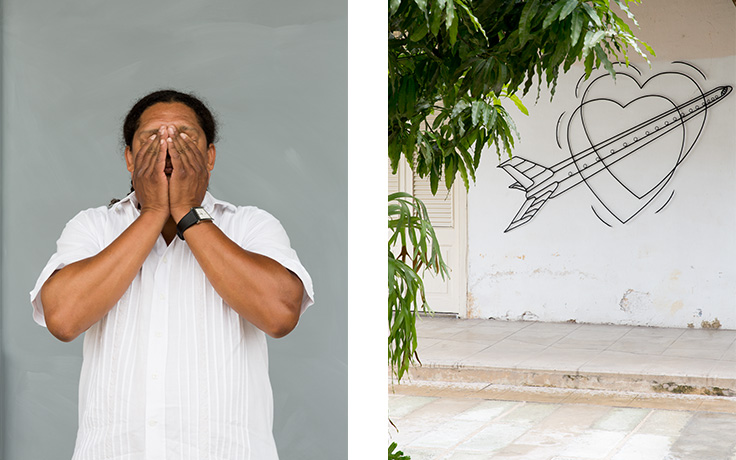
Left: Esterio Segura. Right: Esterio Segura, Hybrid of a Crush, 2009. © Esterio Segura. Courtesy the artist
On a dining-room table in Esterio Segura’s studio is the work 48 Glorious Entries of the Victorious Hero into Havana. It consists of 48 ceramic plates exquisitely painted with images of Castro having sex with a woman. Each woman is an avatar of Cuba, Segura tells me.
Considered one of the most controversial artists of his generation, Segura has been embraced by the US art establishment: the Museum of Latin American Art in Long Beach launched a retrospective of his work last year. Large-scale, conceptual sculptures with a witty, often political message are Segura’s trademark; but he works in many formats and with media including video, photography and paint.
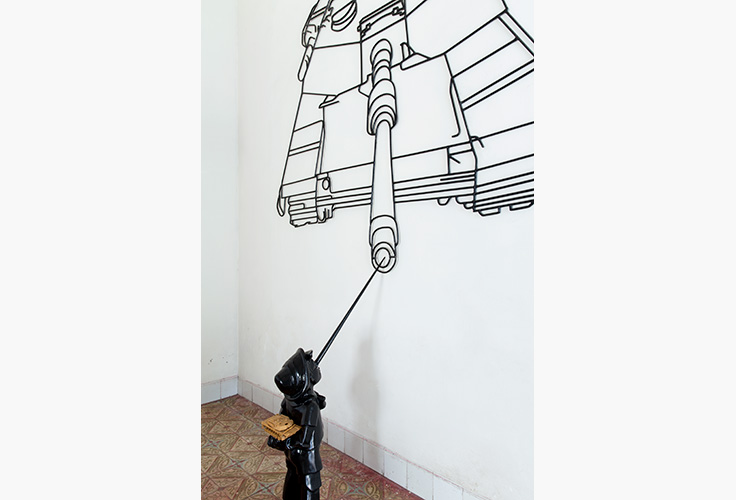
Esterio Segura, Boomerang, 2011. © Esterio Segura. Courtesy the artist
In 2012 his Adiós mi amor was installed in a pedestrian passage off Times Square in New York; it consists of a squadron of red hearts with aircraft wings. They refer to the routine tearing-apart of Cuban families and lovers through emigration, which Segura says is ‘a universal Caribbean motif ’.
He works in a ramshackle house he bought five years ago in the El Cerro district. ‘I wanted to be away from the social movement of the city, and the tourists,’ he says. ‘I wanted somewhere on the periphery, a place charged with all the shades of Cuban culture. People born in this neighbourhood mostly die here. All of the processes of history are here. Traditions, whether Afro-Cuban or Christian, have persisted.’
This is a classic pull for Cuban artists: their own roots inspire them. And Segura has big plans for the next generation, prompted by his sense that art schools in Cuba have lost their magic over the past dozen years. ‘I want to address this in my own way, and will start art apprenticeships for 15-year-olds and upwards within the year.’
2 & 3. Iván and Yoán Capote
For 10 years, Iván Capote has shared his studio, El Búnker, with his more famous brother, Yoán. In this former scrapyard is a beam on the ceiling scavenged from the demolition of the piers of Havana harbour, two years ago. ‘All the artists were down there fighting over the material,’ Iván tells me. Scattered on a table are pliers and fishhooks used for Yoán’s ever-expanding series of paintings of a stormy ocean off the Cuban coast, whose waves would catch those who tried to defect by raft.
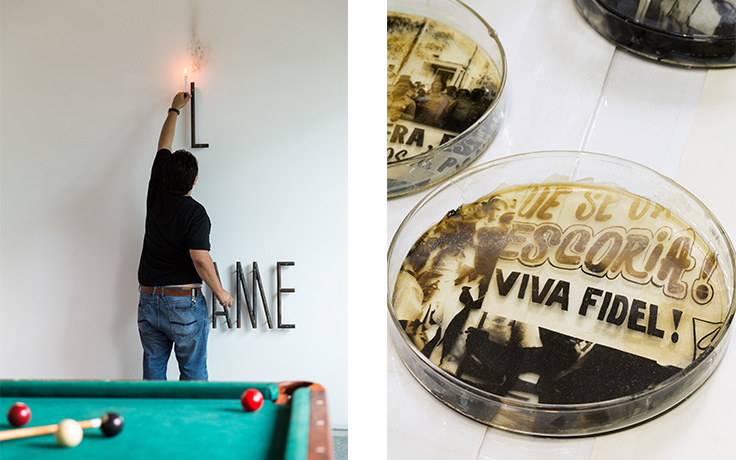
Left: Iván Capote, Vanity, 2010-14 © Iván Capote. © Yoán Capote. Courtesy the artists Right: Yoán Capote,Laboratorio, 2011 – 13, part of an installation. © Iván Capote. © Yoán Capote. Courtesy the artists
On another table are antique chemistry bottles delicately painted with sepia revolutionary slogans. In a corner, a bronze ear is fashioned into a sink; its message is ‘Wash your ears out and remain virtuous’. The brothers have always had an enriching dialogue, says Iván, ‘which we constantly nurture. We share the same tools, the same ideas and conceptions, and the same human values, but we face our projects separately.’ Both explore philosophical and political ideas through minimal, conceptual pieces, Yoán with images and body parts, Iván with single words or poetry fragments.
Things are frequently more sinister than they seem: what looks like an ordinary chair cast in bronze is twisted at the back and adorned with handcuffs. In a beautiful, waxed timber frame hangs the word ‘hoy’, meaning ‘today’. It reads the same when flipped over; so whichever way you look at it, Cubans are (or were until very recently, perhaps) suspended in a perpetual present.
The brothers have acquired the former home of the late Cuban architect Emilio Vasconselos, across the road from their studio; they have called it El Núcleo, the counterpart to El Búnker. The Art Deco house — with light fittings dating from 1935 and a nursery with walls still covered in 1930s Alice in Wonderland wallpaper — is being gently renovated. It will ultimately become a living museum to the Capotes’ work.
See more of Iván Capote’s work. See more of Yoán Capote’s work
4. Juan Roberto Diago Durruthy
Juan Roberto Diago Durruthy’s 1920s house is given over to his work. Large-scale canvases, assemblages, sculptures and installations are stacked neatly alongside works in progress. There’s a huge, well-stocked kitchen, a garden with a pizza oven and birds singing in cages. Friends, family and workers gather here, glowing with affection for ‘Diaguito’, a favourite of Cuban collectors and curators.
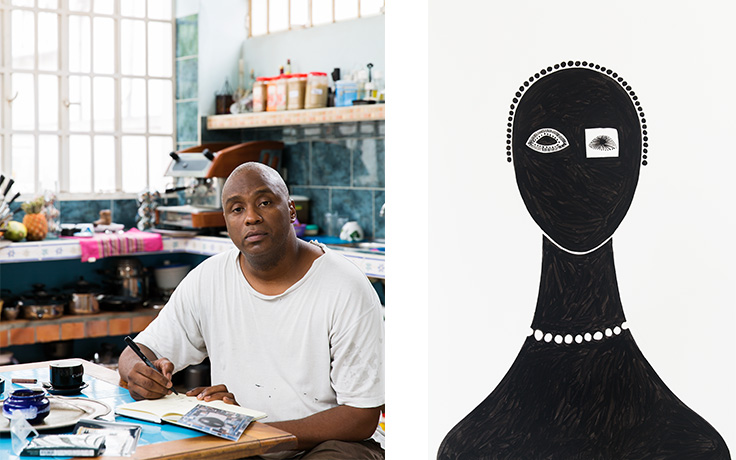
Left: the artist. Right: Juan Roberto Diago Durruthy, Úrsula Lambert, 2000. © Juan Roberto Diago Durruthy. Courtesy the artist
He guides us around, taking the time to explain each piece. The materials are very varied: timber, metal, fabric, cement, paint and objects found locally. Pieces of calico are arranged on one table. Slavery is a theme Diago returns to insistently, and he frequently uses calico because it was the material slaves wore. His work is a commentary on the African slave diaspora, and race, racism and religion in Cuba; it is moving, spiritual and humane. Exploring racism here — in what was formerly a plantation society — has generally been regarded as an act of resistance to the revolution, which ignored the issue in the interests of solidarity. But for Diago, as a black artist, it cannot be ignored.
Self-effacing and unpretentious though he may be, Diago is critically and commercially Cuba’s most successful artist. He fuses the primitive and the refined; some pieces seem very simple, others highly abstract, but there is a crystalline intelligence behind all of them.
Upstairs, in an office crammed with artefacts and rare books — and a collection of slavery documents, from ‘freedom letters’ to identity cards and slave population registers — Diago explains his roots. He comes from an intellectual family, but grew up poor in the barrio of Pogolotti, which he describes as ‘uno de los barrios calientes’ (‘one of the dodgy areas’). His grandfather was Juan Roberto Diago Querol, the leading Cuban painter of the 1940s and 1950s; his grandmother was first violinist in the Havana symphony orchestra.
See more works and watch a video in which Juan Roberto Diago Durruthy offers a tour of his studio
5. Roberto Fabelo
A dramatic thunderstorm at Roberto Fabelo’s house suits his work; but the demeanour of this gentle, studied artist — and the wholesome sounds emanating from the family home — do not. On entering, you are greeted by an oversized portrait of a malevolent, Gothic figure. Drag your eye away, and you spot a globe suspended from the wall, coated with glazed cockroach corpses. Every surface is covered with artefacts, materials and objects — from masks to doll heads — or books.
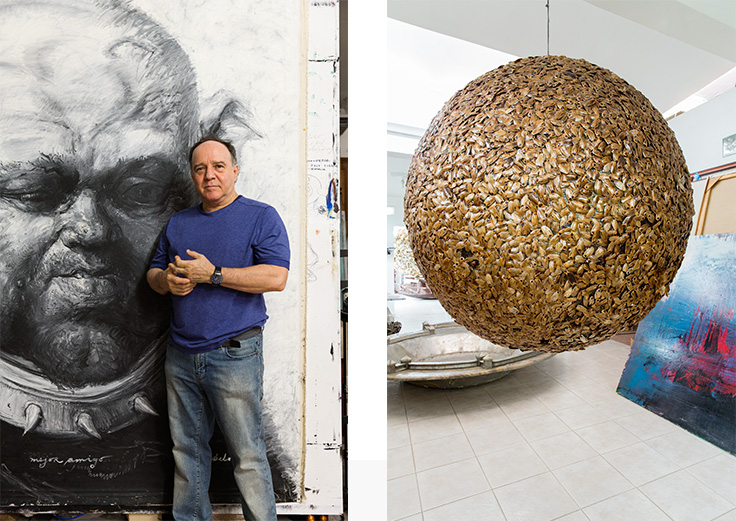
Left: the artist with his 2012 painting Best Friend. Right: Roberto Fabelo, Mundo K, 2005. © Roberto Fabelo. Courtesy the artist
‘It’s a “memory-shell” that protects and stimulates me,’ Fabelo says. Regain your focus, and you are drawn to a vast portrait with a trained, Old Master beauty. In place of an earring, the subject is accessorised with a paintbrush; this is a portrait of Fabelo’s wife and muse, Suyu. The idea seems rather quaint in the 21st-century, but the muse is something his art depends upon: ‘I draw every day, almost viciously, as if that image is tattooed on the surface of my heart, next to the name of my muse, beating together. I cannot imagine any other life.’
His exquisitely realised female nudes are everywhere in Havana, in private homes, museums and dealers’ collections. The female reappears in various incarnations — riding a red rooster or wearing a cockerel mask (both Cuban motifs of maleness), surrounded by fruit, or fraternising with animals and playful demons. Fabelo professes to loathe Latino machismo, ‘but unfortunately, sexism is part of our nature and cannot be removed by decree’.
In a corner of his studio are cooking pots into which macabre faces have been etched. ‘When I see the grime on the surface of these old pots — the memory of fat and fire — I imagine the existence of those who gathered around them in a daily struggle for survival. And then I like, almost sacrilegiously, to scratch my figures on their surfaces.’
At his first US solo show — at Long Beach’s Museum of Latin American Art last year — drawings were inked on the pages of a 19th-century anatomy book, Leo Testut’s Traité d’anatomie humaine. The idea of drawing as an illicit activity gives Fabelo a guilty thrill.
See works by Roberto Fabelo previously sold at Christie’s
6. Kcho
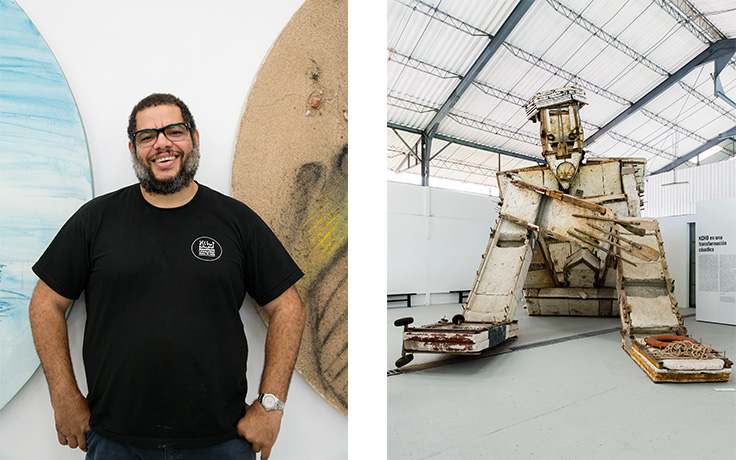
Left: Alexis Leiva Machado, aka Kcho, in his studio. Right: Kcho, The Thinker, 2012-13. © Kcho. Courtesy the artist
Alexis Leiva Machado moves energetically around the Studio Kcho Romerillo Art Laboratory, where teams of workers realise his monumental sculptures, installations and paintings. One minute the artist, who goes by the name of Kcho, is watching sheet metal being cut; the next he is sauntering into his office to work freehand with charcoal on paper.
Detritus of the sea — fragments of boats, driftwood and nets — dominates Kcho’s work. Vast installations reach the roof, among them wooden boats shipwrecked together; down below are charcoal drawings of propellers and oars. His work famously evokes the life of an islander, and Kcho himself is from the beautiful, poverty-stricken Isla de la Juventud. But the constructions also refer to the flimsy rafts which still sometimes depart from Cuba at times of crisis.
Kcho’s studio, on the site of a former rubbish dump in a poor neighbourhood, is nothing so crass as an art gallery. Rather, it’s a non-profit social project by a philanthropic artist who has invested in children’s workshops, a museum, a playground, a graphic studio, a 70-seat community theatre and a public library.
This is not the first time Kcho has devoted himself to bringing art to the masses; he has in the past set up successful ‘art brigades’ throughout Cuba. Acknowledged as the unofficial artist of the revolution, Kcho has been elected deputy of the Popular Power National Assembly. He has also kept the global media abuzz. The opening of his studio in January last year saw a very rare public appearance by Fidel Castro. And at his studio in March this year he rolled out the first free public Wi-Fi zone in Cuba, running off his personal, government-authorised connection. The password? The revolutionary slogan Aquí no se rinde nadie – ‘No one surrenders here’.

